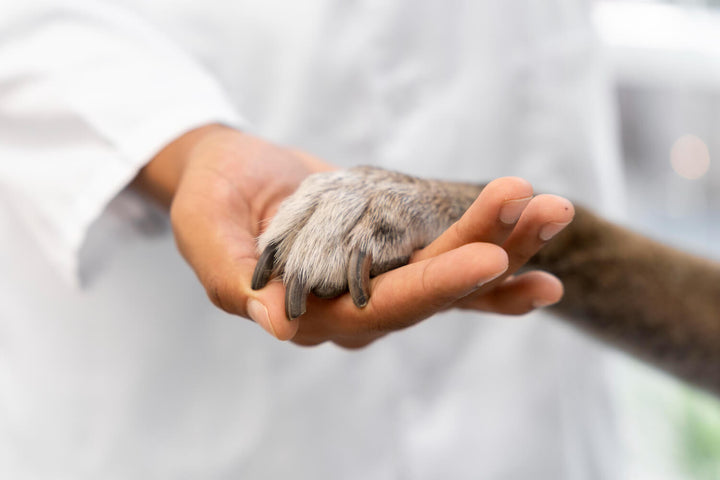Known as the "Gentle Giant" of the dog world, the Newfoundland is a magnificent breed that captures hearts with its massive frame, endearing temperament, and remarkable history. Originating from the Canadian island of Newfoundland, these dogs were initially bred to assist fishermen with their catch. Their incredible swimming abilities and natural water rescue instincts make them a unique and invaluable breed.
Did You Know these Facts about the Newfoundland?
-
Newfoundlands are exceptional swimmers and have saved many lives throughout history. They've even been known to haul drowning victims to safety.
-
These dogs are one of the largest breeds in the world, with males often weighing between 130 to 150 pounds (59 to 68 kg) and standing about 28 inches (71 cm) tall at the shoulder.
-
Despite their imposing size, Newfoundlands are renowned for their gentle and patient nature, particularly with children. They are often referred to as "nanny dogs."
-
Newfoundlands boast a thick double coat, which can be black, brown, gray, or Landseer (black and white). Their webbed feet and powerful tails are built for swimming.
- Unfortunately, these wonderful dogs have a relatively short lifespan, typically living around 8 to 10 years. It's crucial for owners to provide them with excellent care to maximize their time together.
The Newfoundland may not be the most popular breed, but it certainly holds a special place in the hearts of those who have had the privilege of sharing their lives with one.They are ranked 42th most popular breed in the United States, which is quite respectable for a giant breed.

Traits of the Newfoundland Breed
Personality. Newfoundlands are gentle, sweet-natured, and incredibly patient. They're known for their calm and composed demeanor. They are also very protective and loyal to their families, making them excellent watchdogs.
Family Life. These dogs are fantastic family pets. They are great with children and get along well with other pets in the household. Due to their large size, they should be supervised when interacting with smaller kids to avoid unintentional knocks.
Physical Appearance. Newfoundlands have a robust and muscular physique. Their large, webbed paws enable them to swim efficiently. Their thick double coat keeps them warm in cold water. Coat colors include black, brown, gray, and Landseer (black and white).
Sociability. Newfoundlands thrive on human companionship. They are social dogs that love being part of the family activities. They can be a bit reserved with strangers, but they generally warm up quickly.
Average Sizes & Life Expectancy
- Height: 28 to 30 inches tall (71 to 76 cm)
- Weight:100 to 150 pounds (45 to 68 kg)
- Life Expectancy: Around 08 to 10 years
Detailed Description of the Newfoundland Breed
Physical Appearance. One of the first things you notice about a Newfoundland is their sheer size. Males typically weigh between 130 to 150 pounds (59 to 68 kg) and stand about 28 inches (71 cm) tall at the shoulder. This impressive stature is accompanied by a robust and muscular build. Their heads are broad, their chests are deep, and their double coat is thick and water-resistant.
The coat of a Newfoundland can come in various colors, including black, brown, gray, and Landseer (black and white). Their webbed feet and powerful tails are built for swimming, and their dense fur keeps them warm even in cold water. This breed has distinctive features that make them stand out in any crowd.
Temperament and Personality. Newfoundlands are famous for their gentle and patient nature. They are often described as "gentle giants" for a good reason. They are incredibly sweet-natured and known for their calm and composed demeanor. This temperament makes them excellent family pets, especially in households with children. In fact, they are often referred to as "nanny dogs" due to their natural affinity for kids.
Their loyalty knows no bounds, and they are highly protective of their families. While they are gentle giants at heart, they can be a formidable presence if they sense any threat to their loved ones. This combination of patience, protectiveness, and loyalty makes them fantastic watchdogs.
Newfoundlands are social dogs that thrive on human companionship. They love being part of family activities and are known to be excellent with children. Their large size can be intimidating to some, but their gentle disposition quickly dispels any fears.
Adaptability. Despite their enormous size, Newfoundlands can adapt well to different living situations. They are equally comfortable in a spacious rural home and a smaller urban apartment, provided they receive enough exercise and attention. They are generally calm indoors and don't require excessive physical activity indoors.
However, they do need daily exercise to maintain their physical and mental health. Daily walks and playtime are essential. They especially enjoy swimming, and if you have access to water, you'll find that they're in their element.
Due to their large size, Newfoundlands may inadvertently knock over small children, so supervision during playtime is recommended. It's essential to start their socialization and training early to ensure they grow into well-behaved companions.
Care Guidelines. Newfoundlands have a thick double coat that requires regular grooming. Brushing them a few times a week will help prevent matting and reduce shedding. During shedding seasons, which typically occur twice a year, more frequent brushing is needed.
Their ears should be checked regularly for signs of infection, and their teeth should be brushed a few times a week to maintain good oral health. Nail trimming is also essential to prevent discomfort and potential health issues.
Training Strategies. When it comes to training, Newfoundlands are intelligent and eager to please, which makes them relatively easy to train. Positive reinforcement methods work best, as they respond well to praise and rewards. Early socialization is crucial to ensure they are comfortable around other animals and people.
Notable in History. The Newfoundland breed has a rich history. They were originally bred to assist fishermen in their demanding work. These dogs would haul fishing nets, retrieve objects lost overboard, and even save drowning sailors. Their incredible swimming abilities and natural water rescue instincts made them indispensable to Newfoundland's fishing communities.
What about Pop Culture? In pop culture, Newfoundlands have left their mark. Perhaps one of the most famous Newfoundland dogs in history was Seaman, the faithful companion of Meriwether Lewis during the Lewis and Clark Expedition. Seaman was the only member of the expedition to receive a pay scale, and his contributions to the success of the journey were invaluable.
In more recent times, Nana, a Newfoundland dog, played the role of the Darling children's nanny in J.M. Barrie's "Peter Pan." This endearing portrayal showcased the breed's nurturing and protective nature.
In summary, the Newfoundland is a breed of remarkable distinction. Their enormous size is matched only by their enormous heart. They are gentle, patient, and fiercely loyal. While their size may seem imposing, their sweet nature and affinity for children make them wonderful family pets. With proper care, training, and exercise, Newfoundlands thrive in various living situations. Their rich history and presence in pop culture only add to their allure. If you're looking for a loving and devoted companion, the Newfoundland might just be the perfect choice.
What to expect when living with the Newfoundland Breed
Personality. Newfoundlands are known for their calm and composed temperament. They are incredibly patient and gentle, especially with children. Their nurturing nature has earned them the nickname "gentle giants." They are social animals that thrive on human companionship and often form strong bonds with their families. While they are not aggressive, they can be protective, making them excellent watchdogs.
Ideal Environment. Newfoundlands adapt well to different living situations. Despite their large size, they are comfortable in apartments provided they get enough exercise and attention. They enjoy being indoors with their families but need daily walks and playtime. Their love for swimming means they particularly enjoy homes near water.
Maintenance Level. Grooming is a regular part of Newfoundland care. Their thick double coat requires brushing several times a week to prevent matting and reduce shedding. During shedding seasons, more frequent brushing is necessary. Regular ear checks, teeth brushing, and nail trimming are essential for their overall health and comfort. Due to their size, they may accidentally knock over small children, so supervision during playtime is advised.
Overall Health Expectations and Best Health Tests for the Newfoundland Breed
Health Considerations. Newfoundland dogs are generally healthy dogs, but like all breeds, they can be prone to certain health issues.
Some health issues that Newfoundlands are prone to include hip dysplasia, elbow dysplasia, heart diseases like subvalvular aortic stenosis (SAS), bloat, and cystinuria (a hereditary condition that can lead to urinary tract stones). Regular veterinary check-ups are essential to detect and manage these issues early.
Recommended Health Tests. To maintain your Newfoundland's health, several health tests are recommended. These tests include hip and elbow evaluations, cardiac exams, and cystinuria screening. X-rays can reveal joint issues, while cardiac exams help identify heart problems. Cystinuria screening checks for the presence of cystine stones in the urinary tract. Early detection allows for prompt treatment and better management of these conditions.
Best Nutrition, Diet & Supplements for the Newfoundland Breed
Nutrition and Diet. Newfoundlands thrive on a balanced diet that includes high-quality protein, healthy fats, and complex carbohydrates. Protein is crucial for muscle maintenance and overall growth. Ensure that the dog food you choose contains real meat as the primary ingredient. Aim for a protein content of at least 20-25%.
Healthy fats provide a source of energy and help maintain a shiny coat. Look for foods with moderate fat content, around 10-15%. Complex carbohydrates like whole grains and vegetables are excellent sources of energy and fiber. These help with digestion and weight management.
The amount of food your Newfoundland needs depends on factors like age, activity level, and metabolism. As a general guideline, adult Newfoundlands typically require 3-4 cups of high-quality dog food per day, divided into two meals. Puppies may need 4-5 meals daily.
Hydration is Key. Adequate hydration is essential for Newfoundland dogs. Encourage your dog to drink plenty of fresh water.
Supplements. Glucosamine and Chondroitin - These supplements support joint health and can be beneficial, especially as Newfoundlands are prone to hip and elbow dysplasia. Omega-3s help maintain healthy skin and coat, reduce inflammation, and support heart health. Fish oil supplements are a good source.
Foods to Avoid. Newfoundland dogs are susceptible to certain food sensitivities and allergies. Avoid feeding them foods that are known to trigger allergies, such as wheat, corn, and soy. Additionally, refrain from giving them human foods that can be toxic to dogs, including chocolate, grapes, raisins, onions, and garlic.
Grooming Requirements for the Newfoundland Breed
Coat Maintenance and Shedding. Newfoundlands have a double coat consisting of a dense, soft undercoat and a coarse outer coat. They are known for their heavy shedding, particularly during seasonal changes. To manage shedding, regular brushing is essential. Expect to brush your Newfoundland at least 2-3 times a week, if not more during shedding seasons, to remove loose fur and prevent matting.
Paw Care and Hygiene. Newfoundlands have large, webbed feet that help them excel in water activities. Check their paws regularly for any signs of injury or foreign objects. Trim their nails as needed to prevent overgrowth, which can cause discomfort and affect their gait.
Ears and Eyes. Inspect their ears for signs of infection or wax buildup. Clean them gently with a damp cloth if necessary. Keep an eye out for any discharge or redness in their eyes and consult your vet if you notice any issues.
Bathing Frequency. Due to their love for water and mud, Newfoundlands can get dirty quickly. You'll need to bathe them as needed, but avoid overdoing it, as excessive bathing can strip their coat of natural oils. Use a dog-specific shampoo to keep their skin and coat healthy.
Exercise Required for the Newfoundland Breed
Newfoundlands are gentle giants, but they require regular exercise to keep them happy and healthy. Here's what you should know about exercising this breed:
Newfoundlands benefit from daily walks. Aim for at least 30-60 minutes of walking per day to help them burn off energy. These dogs are natural swimmers and truly enjoy the water. If you have access to a safe swimming area, let your Newfoundland indulge in regular swimming sessions. It's an excellent way for them to stay active and cool off during hot weather.
Engage in interactive play sessions, such as fetch or tug-of-war, to keep them mentally and physically stimulated. Newfoundlands enjoy these activities and the bonding time with their owners.
Training Tips for the Newfoundland Breed
Training a Newfoundland can be a rewarding experience due to their intelligence and eagerness to please.
Do…
-
Use positive reinforcement techniques like treats, praise, and toys to reward good behavior.
-
Start socialization early to ensure they are well-adjusted and friendly with other dogs and people.
-
Be consistent with commands and routines to avoid confusion.
-
If needed, use gentle correction methods rather than harsh punishment. Newfoundlands respond well to gentle guidance.
Don't…
-
Use physical punishments or yelling as it can damage the trust between you and your dog.
-
Skip training; consistency is vital. Skipping training sessions can lead to behavioral issues.
- Forget to provide mental stimulation, as these dogs are intelligent and need mental challenges.
The Newfoundland Breed is Suitable For
Due to their large size, Newfoundlands benefit from spacious homes with access to a yard where they can move comfortably. While they can adapt to apartment living, regular outdoor exercise is essential.
Newfoundlands are renowned for their gentle and patient nature, making them excellent family dogs. They are particularly good with children and are often referred to as "gentle giants." Their protective instincts also make them watchful over their human family members.
Newfoundlands are generally good with other pets, including cats and smaller dogs, especially when introduced to them at a young age. Early socialization plays a crucial role in their ability to get along with other animals.
These dogs thrive on companionship and form strong bonds with their owners. They are happiest when included in family activities and given plenty of attention and affection.
The Newfoundland Breed is Not Suitable For
Cramped apartments or homes without access to outdoor areas may not be ideal for Newfoundlands. They require room to move, and their size can make them feel constrained in tight spaces.
Newfoundlands have a thick double coat designed for cold water, so they may struggle in extremely hot and humid climates. If you live in such an area, it's essential to provide ample shade and access to fresh water.
They thrive on human interaction and can suffer from separation anxiety if left alone for long periods. Homes where no one is available for most of the day may not be suitable unless arrangements can be made for their care.
Famous Newfoundland Owners
-
J.M. Barrie - The renowned author of "Peter Pan," J.M. Barrie, was a proud owner of a Newfoundland named Luath. This beloved dog even made it into one of Barrie's novels.
-
Lord Byron - The famous English poet Lord Byron had a Newfoundland named Boatswain. Boatswain is well-known for being honored with a monument larger than Byron's tomb in recognition of his loyalty.
- Captain Meriwether Lewis - The American explorer and leader of the Lewis and Clark Expedition, Captain Meriwether Lewis, had a Newfoundland named Seaman. Seaman accompanied him on his historic journey, providing valuable assistance and companionship.
Accomplishments of the Newfoundland Breed
Newfoundlands are natural water rescue dogs. Their powerful swimming abilities and strong build make them invaluable in water rescue missions. They have saved numerous lives over the years, earning them a special place in the history of water rescue.
Some Newfoundlands have achieved remarkable feats, including setting world records for long-distance water retrieves. Their strength and endurance in the water are legendary.
Newfoundlands have made appearances in literature, film, and television. Their striking appearance and gentle disposition have made them popular choices for dog characters. They've appeared in books like "Nana" from "Peter Pan" and in movies like "The Sandlot."

The History of the Newfoundland Breed
Creation and Purpose. The Newfoundland breed's ancestry can be attributed to a mix of European breeds, including the Great Pyrenees, Mastiff-type dogs, and Portuguese water dogs, which accompanied fishermen to Newfoundland in the 16th century. These dogs were crossbred to create a working breed that could excel in various tasks.
Newfoundlands quickly proved their worth as indispensable helpers for local fishermen. Their strong swimming abilities, thick waterproof coat, and webbed feet made them ideal for water-related tasks. They could retrieve fishing nets, haul loads, and even assist in water rescues, earning them the nickname "Gentle Giants of the Sea."
Early Roles and Evolution. As Newfoundlanders spread to other parts of the world, their dogs accompanied them. In addition to their role as fishing companions, Newfoundlands served as working dogs on farms, pulling carts and assisting in various agricultural tasks. Their calm demeanor also made them excellent draft animals for carrying loads.
The breed gradually gained recognition, and the Newfoundland Club was established in England in 1886. This marked a crucial moment in their history as efforts were made to standardize their appearance and temperament. The breed standard emphasized their strength, size, and gentle disposition.
Changes and Modern Impact. Newfoundlands have evolved from their historical roles but have retained their core characteristics. Today, they are beloved family pets known for their friendly nature, patience, and loyalty. They excel in dog sports such as water rescue, obedience, and draft work.
While the breed's qualities have remained consistent, Newfoundlands have faced challenges due to their size. Some have experienced health issues like hip dysplasia and heart problems, which responsible breeding practices aim to address.
Newfoundlands have enjoyed consistent popularity among dog lovers. Their legacy includes notable appearances in literature and art, such as J.M. Barrie's portrayal of Luath in "Peter Pan" and their presence in famous paintings like Sir Edwin Landseer's "A Distinguished Member of the Humane Society."
The Newfoundland Breed Standard
Newfoundland dogs belong to the Working Group as designated by the American Kennel Club (AKC). This group includes breeds that are known for their strength, intelligence, and versatility, often bred to perform various tasks like guarding, pulling, and rescuing.
The AKC's formal Breed Standard for Newfoundland dogs describes the ideal characteristics of this breed. According to the standard, Newfoundland dogs are large, strong, and well-muscled. They should possess a gentle temperament, intelligence, and a willingness to work. Their coat is thick and water-resistant, consisting of a dense undercoat and a flat, coarse outer coat. Acceptable coat colors include black, brown, gray, and Landseer (black and white). The standard emphasizes the breed's strong build, powerful gait, and sweet expression.
The national breed club for Newfoundland dogs is the Newfoundland Club of America (NCA). You can find more information about this club, including breed standards, events, and resources, on their official website: Newfoundland Club of America.
General Appearance
Head. Newfoundland dogs possess a noble and expressive head. It's broad and massive, with a well-defined stop. The skull is slightly arched from side to side and is crowned with well-set ears. The eyes are dark brown and convey a gentle, intelligent expression.
Muzzle and Nose: Their muzzle is strong and square, and it complements the head nicely. It's about the same length as the skull, leading to a well-defined black nose. In Landseer Newfoundlands, the nose is brown. These features contribute to their unmistakable appearance.
Teeth. Newfoundlands have a complete set of strong, well-aligned teeth. Their bite is level, which means the upper and lower jaws meet evenly. This is important for their working abilities, especially in water rescues.
Neck. Their neck is strong, muscular, and well-arched, blending smoothly into the shoulders. This design helps them excel in tasks like swimming and pulling.
Body. Newfoundlands are known for their robust and sturdy bodies. They have a deep, wide chest and a straight back. The ribcage is well-sprung and extends far back, providing ample lung capacity for endurance. Their loins are muscular and well-supported.
Tail. Their tail is broad at the base and strong. It hangs down when they are at rest, and when they are active, it may be carried slightly above the back, but it should not curl over the back.
Coat. Newfoundland dogs boast a distinctive double coat. The undercoat is soft and dense, while the outer coat is straight, coarse, and water-resistant. This combination allows them to thrive in cold and wet conditions. They also have feathering on the legs and tail, adding to their majestic appearance. Acceptable coat colors include black, brown, gray, and Landseer (black and white).
Size. These dogs are undeniably large and powerful. Adult males typically stand 28 inches at the shoulder and weigh between 130 to 150 pounds (59 to 68 kg). Adult females are slightly smaller, standing about 26 inches at the shoulder and weighing between 100 to 120 pounds (45 to 54 kg).
Gait. Newfoundlands have a distinctive gait. They move with a gentle, rolling motion, which can appear almost effortless despite their size. Their stride is powerful and smooth, making them excellent swimmers and adept at pulling heavy loads on land. This unique gait showcases their incredible strength and grace, defining them as truly majestic dogs.
Reputable Breeders
For those seeking a well-bred Newfoundland, there are reputable breeders who prioritize health, temperament, and the breed's standard. Here are a few notable breeders:
Top Shelters for Adoption
Adopting a dog can be a rewarding experience. Here are a few shelters where you might find a Newfoundland in need of a loving home:
Top 5 Frequently Asked Questions & Answers about the Newfoundland Breed
Are Newfoundland dogs good with children?
Yes, they are known for their gentle and patient nature, making them excellent family pets.
Do Newfoundlands drool excessively?
They can drool, especially after eating or drinking, but not excessively in all cases.
Are they good swimmers?
Absolutely! They have webbed feet and are natural swimmers, often used in water rescue.
Do Newfoundlands require a lot of grooming?
Yes, they have a thick coat that needs regular brushing to prevent mats.
What is their typical lifespan?
Newfoundland dogs typically live 8 to 10 years.
A Final Tip for Bringing a Newfoundland into Your Life
If you're considering bringing a Newfoundland dog into your life, you're in for a loyal and loving companion. These dogs are not only incredibly strong and capable working dogs but also gentle giants that form strong bonds with their families. They excel in water activities and are known for their rescuing abilities. With proper training, socialization, and care, a Newfoundland dog can be a wonderful addition to any family, especially one that enjoys outdoor adventures and needs a loyal protector and friend.
Valuable Resources for Your Journey to Parenting a Newfoundland
At Felicitails you will find many wonderful services, supplies and guides for your life ahead with a loving pup at your side.

Hope You Enjoyed The Read!
Tag Cloud

A warm welcome from Lindsay & Huck (my English Pointer). Hope you enjoy the read and find just what you are looking for when it comes to living your best life with your loved pets.

-
Dog Breeds
(42)
-
Emotional Support Animals
(10)
-
Dog Grooming
(6)
-
Dog Health
(18)
-
Life with a Dog
(18)
-
Dog Nutrition
(11)
-
Service Animals
(11)
-
Dog Training
(5)






